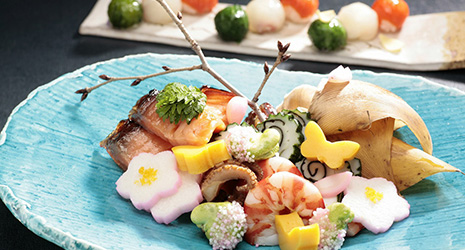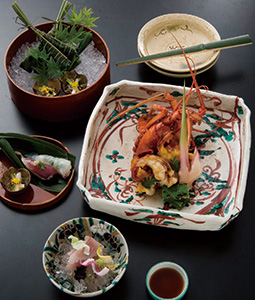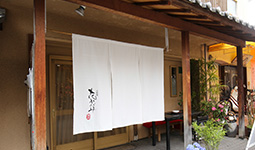Home > Highlighting JAPAN > Highlighting Japan November 2019 > Japan’s Food Culture
Highlighting JAPAN


Washoku: The Expression of Tradition and Expertise
Inscribed on UNESCO’s Representative List of the Intangible Cultural Heritage of Humanity, “Washoku” is the traditional dietary culture that expresses Japanese tradition and expertise.
“In general, Japanese food contains a wide variety of dishes, ranging from traditional recipes to culinary creations from foreign countries adapted to Japanese tastes, such as ramen and curry rice,” says Aso Shigeru, owner of Hanakagami, a traditional Japanese restaurant in Kyoto, and chairman of the board of the All Japan Authorized Cooks Association. “However, the term washoku not only refers to food, such as kaiseki-ryori (a traditional multi-course meal) and kyodo-ryori (regional specialties that have been passed down for generations), it includes the plates, bowls and trays for serving the food, flower arrangements and hanging scrolls adorning the room, and the layout of the garden that opens out from the room. We can say that washoku expresses Japanese tradition and expertise.”
In 2013, Japan’s traditional washoku cuisine was inscribed on UNESCO’s Representative List of the Intangible Cultural Heritage of Humanity. Aso is one of the Japanese cuisine experts, along with academics and government officials, who contributed to this successful listing. Born in Kyoto in 1948, Aso enjoyed eating from a very young age, and his love for delicious food created a path for him to become a chef.
For the dishes served in his restaurant, Aso emphasizes seasonality, creating food tailored to the occasion. For example, the New Year’s festival with a history of over 1,000 years called Hatsu Tenjin takes place at the Kitano Tenmangu Shrine in Kyoto on January 25. It features the custom of eating oysters, which are in season in winter. Aso makes sure to include oyster dishes on the menu of his restaurant.
“There are special dishes to be eaten in accordance with annual events. Thanks to this custom, we know what to eat at home and can consume seasonal ingredients with gusto. This is known as living wisdom.”
The proposal by Japan to UNESCO specified that washoku has characteristics not only related to dishes, such as respect for a variety of fresh ingredients and their natural flavors and a well-balanced healthy diet, but also a close relationship with the four seasons and annual events in Japan, described as representation of the beauty of nature and seasonal transitions and close links with the country’s annual events, such as the New Year. For example, on New Year’s Day people do mochitsuki (making rice cakes by pounding steamed rice in a wooden mortar with wooden mallets) or eat osechi ryori (special food beautifully served with local ingredients in stacked boxes) to welcome the New Year’s gods.
To protect this food culture, shokuiku (food education) programs have been actively conducted in schools and communities throughout the country. There have also been initiatives to spread Japanese food and washoku internationally. As part of these efforts, the Ministry of Agriculture, Forestry and Fisheries has appointed Goodwill Ambassadors to Spread Japanese Cuisine every year since 2015. Aso, who was appointed as an ambassador in 2016, consulted with Japanese restaurants in Shanghai, Bangkok, Macau and other locations. He realized that the skills of local cooks had dramatically improved and Japanese ingredients had become more readily available with improvements in freezing technology, making very delicious Japanese food increasingly accessible overseas. He points out improvements in the handling of food ingredients as a challenge to be addressed in the future.
“In the case of fish, for example, the slaughtering method can have a significant impact on the freshness and taste. The same goes for vegetables—the quality can change greatly with a little ingenuity applied to harvesting and transportation. I believe that these skills cultivated in Japan will not only make food delicious but also aid in the effective use of resources.”
Aso not only wants to disseminate cooking and flavoring techniques from chefs of Japanese food but also other professional skills and knowhow from experts in a variety of related fields.
© 2009 Cabinet Office, Government of Japan









